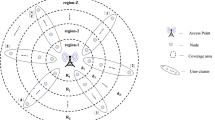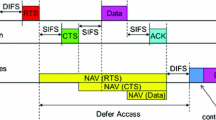Abstract
This paper presents a mathematical model that analyzes the throughput of the IEEE 802.11b distributed coordination function (DCF) with the collision aware rate adaptation (CARA) algorithm. IEEE 802.11 WLANs provide multiple transmission rates to improve system throughput by adapting the transmission rate to the current channel conditions. The system throughput is determined by some stations using low transmission rates due to bad channel conditions. CARA algorithm does not disturb the existing IEEE 802.11b formats and it can be easily incorporated into the commercial wireless local area networks (WLAN) devices. Finally, we verify our findings with simulation.
Similar content being viewed by others
References
Wireless LAN. Medium Access Control (MAC) and Physical Layer (PHY) Specification, IEEE Standard 802.11, 1999.
A. Kamerman, L. Monteban. WaveLAN/sup R/-II: A high performance wireless lan for the unlicensed band. Bell Labs Technical Journal, vol. 2, pp. 118–133, 1997.
S. H. Y. Wong, H, Yang, S. Lu, V. Bharghavan. Robust rate adaptation for 802.11 wireless networks. In Proceedings of the 12th Annual International Conference on Mobile Computing and Networking, ACM, Los Angels, CA, USA, pp. 146–157, 2006.
J. Kim, S. Kim, S. Choi, D. Qiao. CARA: Collision aware rate adaptation for IEEE 802.11 wireless LANs. In Proceedings of IEEE INFOCOM, the 25th IEEE International Conference on Computer Communications, Barcelona, Spain, pp. 1–11, 2006.
J. H. Yun. Throughput analysis of IEEE 802.11 WLANs with automatic rate fallback in a lossy channel. IEEE Transactions on Wireless Communications, vol. 8, no. 2, pp. 689–693, 2009.
J. P. Pavon, C. Sunghyan. Link adaptation strategy for IEEE 802.11 WLAN via received signal strength measurement. In Proceedings of IEEE International Conference on Communications, IEEE, Anchorage, USA, vol. 2, pp. 1108–1113, 2003.
S. Lee, K. Chung. Channel quality-based rate adaptation scheme for wireless networks. In Proceedings of IEEE International Conference on Information Networking, IEEE, Busan, Korea, pp. 1–5, 2008.
H. Jung, K. Cho, Y. Seok, T. Kwon, Y. Choi. RARA: Rate adaptation using rate-adaptive acknowledgment for IEEE 802.11 WLANs. In Proceedings of the 5th IEEE International Conference on Consumer Communications and Networking Conference, Las Vegas, USA, pp. 62–66, 2008.
B. Sadeghi, V. Kanodia, A. Subharwal, E. Knightly. OAR: An opportunistic auto-rate media access protocol for ad hoc networks. Wireless Networks, vol. 11, no. 1–2, pp. 39–53, 2005.
G. Holland, N. Vaidya, P. Bhal. A rate-adaptive MAC protocol for multihop wireless networks. In Proceedings of the 7th Annual International Conference on Mobile Computing and Networking, ACM, Rome, Italy, pp. 236–251, 2001.
G. Bianchi. Performance analysis of the IEEE 802.11 distributed coordination function. IEEE Journal on Selected Areas in Communications, vol. 18, no. 3, pp. 535–547, 2000.
D. Senthilkumar, A. Krishnan. Nonsaturation throughput enhancement of IEEE 802.11b distributed coordination function for heterogeneous traffic under noisy environment. International Journal of Automation and Computing, vol.7, no. 1, pp. 95–104, 2010.
M. Ergen, P. Varaiya, S. J. Wichorus. Formulation of distributed coordination function of IEEE 802.11 for asynchronous networks: Mixed data rate and packet size. IEEE Transactions on Vehicular Technology, vol. 57, no. 1, pp. 436–447, 2008.
T. S. Rappaport. Wireless Communications: Principle and Practice, New Jersey, USA: Prentice Hall, 2001.
The network simulator — ns-2. [Online], Available: http://www.isi.edu/nsnam/ns/, May 12, 2009.
Intersil. HFA3861B: Direct Sequence Spread Spectrum Baseband Processor, 2000.
Author information
Authors and Affiliations
Corresponding author
Additional information
Dhanasekaran Senthilkumar received the B.Eng. degree from Bharathiar University, Coimbatore, India in 1997, and the M.Tech. degree from Sastra University, Tanjavore, India in 2002. From 2002 to 2007, he was working as a lecturer in K. S. Rangasamy College of Technology, Tamilnadu, India. He is currently a Ph.D. candidate in Anna University, Chennai, India, and also a professor in Department of Electronics and Communication Engineering, K. S. Rangasamy College of Technology, India. He is a member of IETE and ISTE.
His research interests include performance analysis and quality of service of wireless local area networks.
A. Krishnan received the Ph.D. degree from IIT Kanpur, Kanpur, India. He is currently a professor with K. S. Rangasamy College of Technology, Tiruchengode, Tamilnadu, India. He is a member of IEEE, IETE, and ISTE.
His research interests include quality of service of high speed networks, signal processing, and network security.
Rights and permissions
About this article
Cite this article
Senthilkumar, D., Krishnan, A. Throughput analysis of IEEE 802.11 multirate WLANs with collision aware rate adaptation algorithm. Int. J. Autom. Comput. 7, 571–577 (2010). https://doi.org/10.1007/s11633-010-0542-4
Received:
Revised:
Published:
Issue Date:
DOI: https://doi.org/10.1007/s11633-010-0542-4




